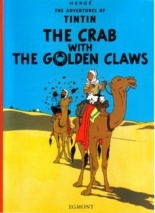First published in French in 1941. Tintin sets off for North Africa and thwarts a scheme by criminals who hide opium in tins of crab meat. Tintin meets Haddock, who will become his side-kick.
The Adventures of Tintin (Les Aventures de Tintin) is a series of comic strips created by the Belgian artist Georges Rémi (1907–1983), who wrote under the pen name of Hergé. The series first appeared in French in Le Petit Vingtième, a children’s supplement to the Belgian newspaper Le Vingtième Siècle on 10 January 1929. The success of the series saw the serialised strips collected into a series of twenty-four albums, spun into a successful magazine and adapted for film and theatre. The series is one of the most popular European comics of the 20th century, with translations published in more than 50 languages and more than 200 million copies of the books sold to date. #1016R/0420/0621
The Crab with the Golden Claws (French: Le Crabe aux pinces d’or) is the ninth volume of The Adventures of Tintin, the comics series by Belgian cartoonist Hergé. The story was serialised weekly in Le Soir Jeunesse, the children’s supplement to Le Soir, Belgium’s leading francophone newspaper, from October 1940 to October 1941 amidst the German occupation of Belgium during World War II. Partway through serialisation, Le Soir Jeunesse was cancelled and the story began to be serialised daily in the pages of Le Soir. The story tells of young Belgian reporter Tintin and his dog Snowy, who travel to Morocco to pursue a gang of international opium smugglers. The story marks the first appearance of main character Captain Haddock.
The Crab with the Golden Claws was published in book form shortly after its conclusion. Hergé continued The Adventures of Tintin with The Shooting Star, while the series itself became a defining part of the Franco-Belgian comics tradition. In 1943, Hergé coloured and redrew the book in his distinctive ligne-claire style for Casterman‘s republication. The Crab with the Golden Claws introduces the supporting character Captain Haddock, who became a major fixture of the series. The book is the first Tintin adventure published in the United States and the first to be adapted into a motion picture. The Crab with the Golden Claws was adapted for the 1947 stop motion film of the same name, the 1956 Belvision Studios animation Hergé’s Adventures of Tintin, the 1991 Ellipse/Nelvana animated series The Adventures of Tintin, the feature film The Adventures of Tintin: The Secret of the Unicorn (2011) directed by Steven Spielberg, and the film’s tie-in video game.
Tintin is informed by Thomson and Thompson of a case involving the ramblings of a drunken man, later killed, found with a scrap of paper from what appears to be a tin of crab meat with the word “Karaboudjan” scrawled on it. His subsequent investigation and the kidnapping of a Japanese man interested in giving him a letter leads Tintin to a ship called the Karaboudjan, where he is abducted by a syndicate of criminals who have hidden opium in the crab tins. Tintin escapes from his locked room after Snowy chews through his bonds and Tintin knocks out a man sent to bring him food, leaving the man bound and gagged in the room. Tintin encounters Captain Haddock, an alcoholic sea captain, who is manipulated by his first mate, Allan, and is unaware of his crew’s criminal activities. Tintin hides in the locker under the bed and defeats Jumbo, the sailor left in the cabin, while Allan thinks Tintin has climbed out of the porthole back into the storeroom. He blows open the storeroom door, then finding it empty goes back to the Captain’s room, where he finds Jumbo tied to a chair and gagged. Tintin, Snowy, and Haddock escape the ship in a lifeboat after sending a radio message to the police about the cargo, and a seaplane tries to attack them. Tintin and the Captain hijack the plane, tie up the pilots, and try to reach Spain. Haddock’s drunken behaviour in a storm causes them to crash-land in the Sahara, where the crew escapes.[1]
After trekking across the desert and nearly dying of dehydration, Tintin and Haddock are rescued and taken to a French outpost, where they hear on the radio the storm has sunk the Karaboudjan. They travel to a Moroccan port, and along the way are attacked by Tuareg tribesmen, defending themselves with French MAS-36 rifles. At the port, members of his old crew kidnap the Captain after he recognises their disguised Karaboudjan. Tintin meets Thomson and Thompson who got his message, and they learn that the wealthy merchant Omar ben Salaad sold the crab tins; Tintin tells Thomson and Thompson to discreetly investigate. Tintin tracks down the gang and saves the Captain, but they both become intoxicated by the fumes from wine barrels breached in a shootout with the villains. Haddock chases a gang-member from the cellar to an entrance behind a bookcase in Salaad’s house. Upon sobering up, Tintin discovers a necklace of a crab with golden claws on the now-subdued owner of the wine cellar, Omar ben Salaad, and realizes that he is the leader of the drug cartel. Allan steals a boat and tries escaping, but Tintin captures him. The police arrest the gang and free the Japanese man, who introduces himself as Bunji Kuraki, a police detective who was trying to warn Tintin of the group he was up against. He had been investigating the sailor on Haddock’s crew who drowned; the sailor was on the verge of bringing him opium before he was eliminated. Turning on the radio, Tintin learns that, thanks to him, the entire organisation of the Crab with the Golden Claws is behind bars.[2]
#250124R
